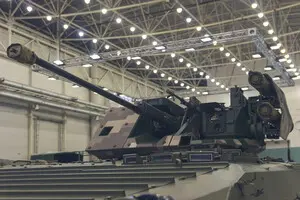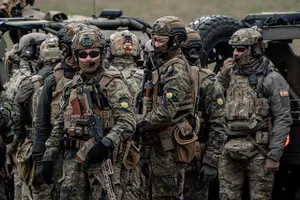European Weapons With Ukrainian Experience: A Plan That Will Change Continental Security

Ukraine has every chance to become part of the European defense ecosystem in the short term. How to do it? Combine our best technological developments and combat experience with the capabilities of defense businesses in the EU and NATO countries. Demonstrate to Europeans that it is with Ukrainian producers that they can solve their key problem: to get effective weapons faster and strengthen the defense forces of the entire continent.
A window of opportunity for Ukraine
Tectonic shifts in the perception of external threats in Europe have taken place: recent polls by Ipsos and other researchers show that amid the threat from Russia and changes in US foreign policy, more and more Europeans support their governments' initiative to increase defense spending. In the UK and Germany, 45 percent of respondents support this idea, and in France, more than 60 percent of citizens are willing to pay more taxes to strengthen defense.
The European Union has already recognized the critical need to reduce its dependence on US suppliers, which accounted for about 60 percent of all defense contracts. Last week, European Commission President Ursula von der Leyen presented an ambitious plan — ReArm Europe — which envisages mobilizing 800 billion euros for defense purposes.
The final version is still being formed, but it is based mainly on debt financing. It has been announced that €650 billion can be accumulated through fiscal easing, new budget programs and private capital mobilization. Another 150 billion euros are planned to be raised through a new financial mechanism defined in the Treaty on the Functioning of the EU. The main goal is already clear: the money for defense contracts will work as an investment in the development of the defense industry of the EU member states.
The goals in regard to Ukraine are also defined. They are positive for us: Europe's strategic rearmament plan is aimed at increasing comprehensive defense support for Ukraine. However, we are faced with an urgent need to move away from the practice of meeting only critical needs and pay attention to the capabilities of the Ukrainian defense industry.
A year ago, the European Commission approved the European Defense Industrial Strategy (EDIS), which is the regulatory framework for ReArm Europe. For the first time, a non-EU country, Ukraine, has been assigned a role in the future development of the European defense sector. The idea of the strategy is to deepen the integration of the Ukrainian and European defense industries. The EDIS recognizes Ukraine's role as a critical partner in the defense industry, takes into account the potential participation of Ukrainian companies in joint arms procurement and supports the scaling up of joint production with European manufacturers.
What is the problem with implementation? The established practice in Europe is that each country supports its own manufacturer. This has already led to market fragmentation and a lack of real standardization of weapons, ammunition and spare parts. EDIS and ReArm Europe aim to break this practice. However, the ongoing negotiations on the implementation of EDIS show that at least some European governments are not ready to abandon it.
The final configuration of ReArm Europe and its instruments will be determined sooner rather than later. For Ukraine, the window of opportunity is still wide open. Europe still demonstrates its readiness not only to support but also to consider the Ukrainian defense industry as a source of technology, experience and joint development.
This interest may fade into the background if Ukraine does not formulate a clear strategy for integrating its companies into new European defense processes. It is up to us to ensure that Europe reaches a new level of awareness: with Ukrainian manufacturers, it will be able to solve its key problem of obtaining effective weapons faster and strengthening the defense capabilities of the entire continent.
How to intensify the search for joint opportunities with Ukraine? To cooperate with the EU in the production, development and improvement of defense technologies, replacement of components and materials in supply chains from third countries.
What does Europe need and what can Ukraine do?
The challenges facing Europe are unprecedented. Analysts at Breugel and the Kiel Institute for World Economics have calculated their scale: to counter a potential Russian invasion of the Baltic states, Europe needs at least 1,400 tanks, 2,000 armored personnel carriers, 700 artillery systems, 1 million artillery shells and 300,000 highly trained troops. This will be enough for 90 days of intense fighting. This combat power far exceeds the combined capabilities of the ground forces of France, Germany, Italy and the United Kingdom.
The European Commission will present its analysis — White Paper on the future of European defense — on March 19.
However, it is already possible to identify the problems in Europe's defense sector that will require joint efforts:
- lack and fragmentation of missile and air defense systems;
- lack of capacity and slow production of UAVs (and countermeasures against them) amid the rapid evolution of these technologies;
- inefficient production and problems with scaling due to market fragmentation and high unit costs (cost-to-kill ratio);
- lack of a unified defense procurement system.
What Ukrainian capabilities might Europe be interested in?
Firstly, the inclusion of Ukrainian "mil-tech" in joint development, procurement and supply chains, as well as the right approach to technology protection, can create a segment of the defense market that will go beyond Ukraine. Partner governments have already begun to reconsider their approaches to conventional weapons and pay more attention to easily scalable products with a lower cost-to-kill ratio as opposed to expensive and slow-to-produce solutions.
Secondly, cluster solutions: from equipment repair, development of assembly facilities, installation of subsystems to full production with technology transfer. The first steps in this direction have already been taken. Ukroboronprom has established joint ventures with the German concern Rheinmetall and the French company Thales. Brussels is interested in scaling up and developing both these and joint research projects.
Thirdly, joint research and development initiatives with the possibility of industrialization. The implementation of the Eurodrone project (development began in 2015, and the first tests are scheduled for 2027) has demonstrated that the speed of innovation is of unprecedented importance. Ukraine has already shown that it can not only quickly introduce new developments, but also (and even more importantly) regularly modernize them in accordance with military needs.
The path to real projects
Moving from "having valuable experience" to "becoming a partner" requires Ukraine to analyze existing initiatives in detail and look for opportunities to expand them in the EU. The so-called Danish model is already working: financing Ukrainian arms manufacturers with money from European governments. The UK's initiatives on direct procurement and co-financing through the International Fund for Ukraine are expanding for our manufacturers. Poland is ready to work with Ukrainian drone manufacturers to adapt its own production to the current wartime conditions.
The question we need to answer quickly is how to turn these initiatives from just helping Ukraine to jointly building up European defense capabilities. The search for an answer should begin with cooperation with all stakeholders: from government agencies to industry associations and specific companies. For example, the Ukraine Facility Platform is creating a Business Council that will become a platform for developing the Collaborative Effort Toolkit. This is a toolkit for effective partnership between government and business in implementing pilot projects that can be scaled up in both Ukraine and the EU. It is the business that is interested in becoming a driver of the necessary changes in national regulation and creating algorithms for interaction with other stakeholders. There is no time to wait for someone else to do it, so get involved.
The window of opportunity is still wide open for us. Therefore, it is crucial to convey to the EU concrete proposals that meet the common economic and strategic interests of Ukraine and Europe. This is the only way Ukraine can become a part of the ReArm Europe plan, and not a line item in European budgets.
Please select it with the mouse and press Ctrl+Enter or Submit a bug















 Login with Google
Login with Google